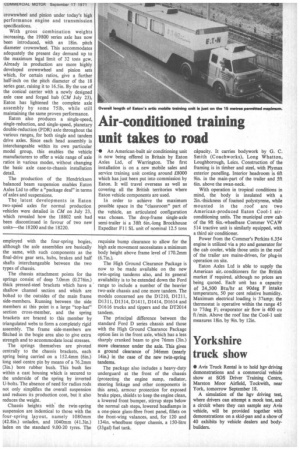Jubilee-year Eaton has 60/70-ton bogie
Page 44

Page 45

If you've noticed an error in this article please click here to report it so we can fix it.
on the way by Gordon Crabtree
• With the introduction shortly of a 44D version of its tandem-drive bogies, Eaton Axles Ltd will be able to offer axle sets for use at up to 60 or 70 tons gcw. The new model will be an extension of the 30 and 38D series of tandem bogies which already cater for haulage capacities up to 44 tons gcw; they maintain to a high degree the international interchangeability which has been achieved with the single-drive two-speed Eaton axles.
The name Eaton has been synonymous with two speed axles since the first commercially produced example became available on the American market in the 1930s. But this month Eaton Axles Ltd celebrates its 25th anniversary and has achieved the distinction of being the largest producer of commercial vehicle rear axles in the world. The UK plant produces more than 40,000 units a year.
It was in 1946 that the firm started production in Britain with three basic models of two-speed axle, the 13500, the 16500 and the 18500. These axles (the 13500 known almost universally as the 1350 for some odd reason) enjoyed a successful service life but increasing engine powers brought a demand for higher-rated units. The first change came in 1960 with the introduction of modified pinion bearings with approximately 25 per cent additional capacity. In the case of the 13 and 16 series axles a change was made from a Timken 53 series bearing to an HM 903, and in the 18 series, from a 55 series to an HM 907. Tc keep step with a balanced design, tilt crownwheel pitch diameter and tooth fact widths were modified. The 1350, with pitel diameter of 12.375in., went up to 13.751n. the 16500 from 14.1251n. to 14.875in. ant the 18500 from 15.25in. to 16.0in. At this juncture, extra capacity was built into th( differential by modifying the toot} combination between differential pinion an the side gear from 11 x 20 to 10 x 18. Thi! had the effect of balancing the stresses ir the differential pinion and side gear, thut affording improved differential service life.
In 1962 the induction-hardened half-shaf was introduced into the British productior in place of the through-hardened shafts. Ii the past two years, bearing in mind tho importance of higher-performance, lower weight components. Eaton has introduce( the conical type carrier which, beside bein lighter in weight by some 301b, affords at improved stress condition in supporting th,
crownwheel and pinion under today's high performance engine and transmission specifications.
With gross combination weights increasing, the 19800 series axle has now been introduced, with an I8in. pitch diameter crownwheel. This accommodates adequately the present day demand up to the maximum legal limit of 32 tons gcw. Already in production arc more highly developed crownwheel and pinion sets which, for certain ratios, give a further half-inch on the pitch diameter of the 18 series gear, raising it to I6.5in. By the use of the conical carrier with a newly designed axle case and forged hub (CM July 23), Eaton has lightened the complete axle assembly by some 751b, while still maintaining the same proven performance.
Eaton also produces a single-speed, single-reduction, and single-speed, planetary double-reduction (PDR) axle throughout the various ranges, for both single and tandem drive axles. Since each head assembly is interchangeable within its own particular model group, this enables the vehicle manufacturers to offer a wide range of axle ratios in various modes, without changing the basic axle case-to-chassis installation detail.
The production of the Hendrickson balanced beam suspension enables Eaton Axles Ltd to offer a "package deal" in terms of axles and suspensions.
The. latest developments in Eaton two-speed axles for normal production vehicles were detailed in CM on July 23, which revealed how the 18802 unit had been discontinued in favour of two new units—the 18200 and the 18220.




















































































































